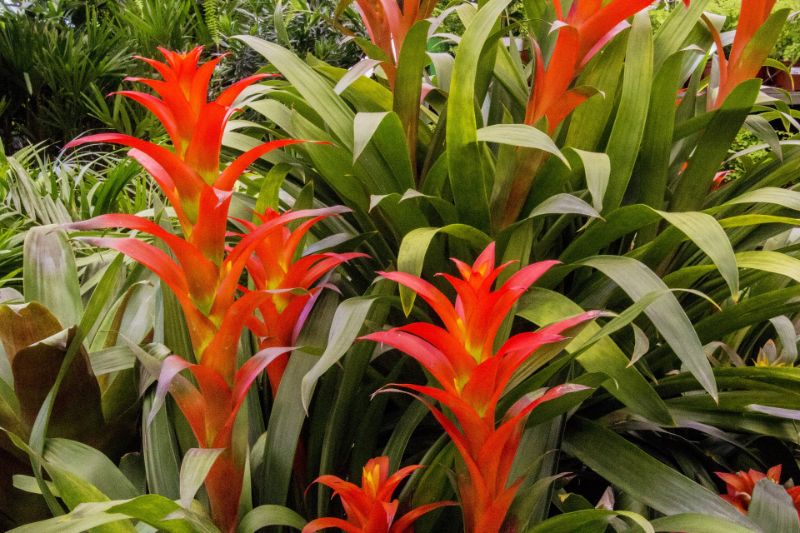Bromeliads are tropical plants that can be found in a variety of colors and sizes. While they don’t require much care, Bromeliads will thrive if you give them the right fertilizer. On this page, we’ll go over the best fertilizer for Bromeliads grown in soil as well as air plants.
Best Fertilizer for Bromeliads
Best Fertilizer for Bromeliads
Aquatic Arts Bromeliad Fertilizer Liquid Plant Food for Bromeliads | Cryptanthus, Guzmania, Neoregelia Aechmea and Tillandsia Air
Aquatic Arts Bromeliad Fertilizer Liquid Plant Food (Buy Online) has been specifically formulated for growing bromeliads and it contains 16% nitrogen (N), 9% phosphorus (P), and 25% potassium (K). And it’s gentle enough to use every time you water your plants without burning leaves or causing damage to roots.
Aquatic Arts works on all types of bromeliads and this fertilizer was specifically formulated with the right balance of nutrients needed to keep a wide range of Bromelisas healthy in any habitat. Plus, this fertilizer includes instructions for different feeding schedules depending on whether you have an epiphyte (air-plant) or terrestrial (ground-based) species.
The Grow Co Bromeliad Plant Food – Organic Liquid Fertilizer
Grow Co Bromeliad Plant Food (Buy Online) is a nutrient-rich fertilizer that contains safe, all-natural CDFA Certified Organic ingredients that stimulate colorful flowers and vibrant blooms on any indoor or outdoor bromeliad plant. And the balanced mix of essential nutrients helps promote stunning blooms while maintaining healthy leaves and stems. Plus, it also comes in a concentrated solution so you can easily mix up a batch to have on hand to apply directly to your plant’s leaves to give them a quick nutrient boost.
Florikan Dynamite 10-10-17 Orchids & Bromeliads Fertilizer, 1 lb
Florikan Dynamite 10-10-17 Orchids & Bromeliads Fertilizer (Buy Online) is the best fertilizer for indoor and outdoor bromeliads because it feeds plants for up to nine months. It’s also environmentally friendly and contains no animal by-products or harmful chemicals.
This fertilizer contains all the nutrients your plant needs so you can enjoy your bromeliad year-round. All you need to do is add the recommended amount of Dynamite 10-10-17 Orchids & Bromeliads Fertilizer, water as usual, and watch your plants thrive. And there will be no more guessing what’s best for your plants since this time-release fertilizer will ensure your plants have a steady supply of nutrients.
TeaDrops Organic Orchid + Bromeliad + Air Plant Fertilizer
TeaDrops (Buy Online) is a new fertilizer that makes it easy for you to give your favorite plants exactly what they need. It’s made out of 100% organic ingredients, so there’s no risk of hurting your plant with synthetic chemicals. And with TeaDrops, you’ll never have to worry about over-fertilizing again.
This special formula helps all kinds of terrestrial and epiphytic plants grow strong and healthy by providing just the right amount of nutrition every time you water them. And each cylinder contains 16 TeaDrops that make up to 32 Gallons of fertilizer – making it incredibly affordable compared to other fertilizers on the market.
Better Gro Orchids, Bromeliads & Houseplant Slow Release Plant Food / Fertilizer
Better Gro Bromeliad & Orchid Slow Release Plant Food (Buy Online) makes it easy to provide your plants with the nutrients they need, so you don’t have to worry about getting the ratios just right every time you fertilize your Bromeliads. And this slow-release fertilizer includes easy-to-follow instructions and tips for applying the fertilizer correctly, so it’s easy for anyone to use.
Best Bromeliad Fertilizer for Air Plants
The Drunken Gnome Tillandsia Air Plant Food and Fertilizer
Drunken Gnome Tillandsia Air Plant Fertilizer (Buy Online) is perfect for busy people who want beautiful air plants without a lot of hassle. This all-natural formula will help you create lush green leaves and vibrant flowers that last longer than ever before. This air plant fertilizer kit even includes an 8 oz mister spray bottle so you can easily apply this nutrient mist to your air plants every time you water your plants.
Sungrow Air Plant Fertilizer for Bromeliads
SunGrow Air Plant Fertilizer (Buy Online) helps you maintain your epiphytic bromeliad without all the hassle by allowing you to fertilize them with just water. Just pour the fertilizer into an empty spray bottle (included), fill it up with water, mix well and spray on your plants once every week. You’ll soon see new buds growing from your plants within weeks – plus no more dead leaves or brown spots.
What is The Best Fertilizer for Bromeliads
Epiphytic plants such as bromeliads grow naturally in trees and other plants where they collect their nutrients from rain and dust that fall onto their leaves. Because of this, they don’t need a lot of fertilizer to thrive; in fact, too much fertilizer can be harmful.
Look for an epiphytic/bromeliad/non-urea nitrogen fertilizer that is low in nitrogen and phosphorus (phosphorus can be harmful to epiphytes) and that has a relatively high potassium content. A good mix might be something like 17-8-22.
Bromeliad Fertilizer NPK Ratio – Bromeliad Fertilizer (17-8-22)
The best NPK ratio for bromeliad fertilizer is 17-8-22. This means that the fertilizer has a concentration of 17% nitrogen (N), 8% phosphorus (P2O5), and 22% potassium (K2O). For optimal results, it is recommended to fertilize your bromeliads with a fertilizer with this particular NPK ratio every 2-4 weeks.
How Do Bromeliads Get Nutrients
Bromeliads that grow in the soil get nutrients via their roots, while epiphytic bromeliads – those that grow on trees or other plants – get their nutrients from the air and rain. The leaves of a bromeliad are efficient at trapping water and small bits of organic matter, which provides them with a limited amount of nutrients. To supplement their nutrient needs, many gardeners will fertilize their bromeliads periodically with a liquid fertilizer.
How To Fertilize Bromeliads
Bromeliads are beautiful, but tricky to care for plants. You can fertilize them with your choice of fertilizer or compost tea by pouring it into the center of the plant’s rosette and then let it soak in. You can also apply fertilizer to the soil at the base of the leaves and water it in well so that the fertilizer reaches all parts of the root system.
When To Fertilize Bromeliads
Bromeliads should be fertilized once a month in the spring and summer, but not at all in the fall or winter. Fertilize with a balanced liquid fertilizer (17-8-22 is a good example) diluted to a quarter strength.
Troubleshooting Bromeliads – Bromeliad Problems
Bromeliad Leaves Turning Yellow
There are a few things that could be causing your bromeliad’s leaves to turn yellow. One possibility is that the plant is lacking nitrogen. You can remedy this by using a mild nitrogen fertilizer. Another possibility is that the plant is lacking iron. If this is the case, you can add a bit of chelated iron to your nutrient solution.
Bromeliad Leaves Turning Brown
There are a few potential reasons your bromeliad’s leaves might be turning brown. One possibility is that the plant is not getting enough water – bromeliads need to be watered regularly, especially if they’re in a pot. Another possibility is that the plant has been infected by pests – look for evidence of insects on the leaves and try treating the plant with an insecticide or miticide if necessary.
A third possibility is that the plant isn’t getting enough light – bromeliads need plenty of direct sunlight in order to stay healthy. If your plant is currently located in a dark corner of the room, consider moving it somewhere else where it will receive more light
Bromeliad Leaves Drooping
One potential cause of bromeliad leaves drooping is a lack of water. Bromeliads are tropical plants and need to be kept moist, so make sure you’re watering them regularly.
Another possible cause is a fungal disease. Symptoms of fungal disease include black spots on the leaves and stems, as well as wilting or drooping leaves. If you think your bromeliad may have a fungal infection, apply an organic fungicide to treat it.
Insects can also be responsible for drooping bromeliad leaves. Look for signs of insect damage such as holes in the leaves or sap leaking from the stem.
Bromeliad Leaves Turning Black
Bromeliad leaves turning black could mean your bromeliad is suffering from a fungal disease, in which case you’ll need to treat it with a fungicide. It’s also possible that the plant is experiencing a potassium or phosphorus deficiency, in which case you can give it a dose of liquid fertilizer. If the leaves continue to turn black and die, then it’s likely that the plant is beyond saving and will need to be replaced.
Bromeliad Leaves Splitting
The leaves of a bromeliad may split if the plant is not getting enough humidity or water. You can increase the humidity around the plant by placing it near a humidifier. And if the problem persists, you may need to water your plant more often.
Bromeliad Leaves Curling
Bromeliad leaves curling can be caused by a number of things, but one of the most common reasons is that the plant isn’t getting enough water. Make sure you’re watering your bromeliad regularly and keeping it in a moist environment.
Bromeliad Not Blooming
One possible reason your bromeliad is not blooming is that it’s not getting enough phosphorus. Phosphorus is a key nutrient for flowering plants and is essential for the production of flowers and fruit.
Another possible reason is that your bromeliad isn’t getting enough light. Bromeliads need plenty of bright light to flower successfully. If it’s growing in a shady spot, it may not be getting enough light to bloom.
Lastly, another possible reason why your bromeliad isn’t blooming could be due to it having too short of a photoperiod. Bromeliads typically need at least 14-16 hours of light each day in order to flower.












